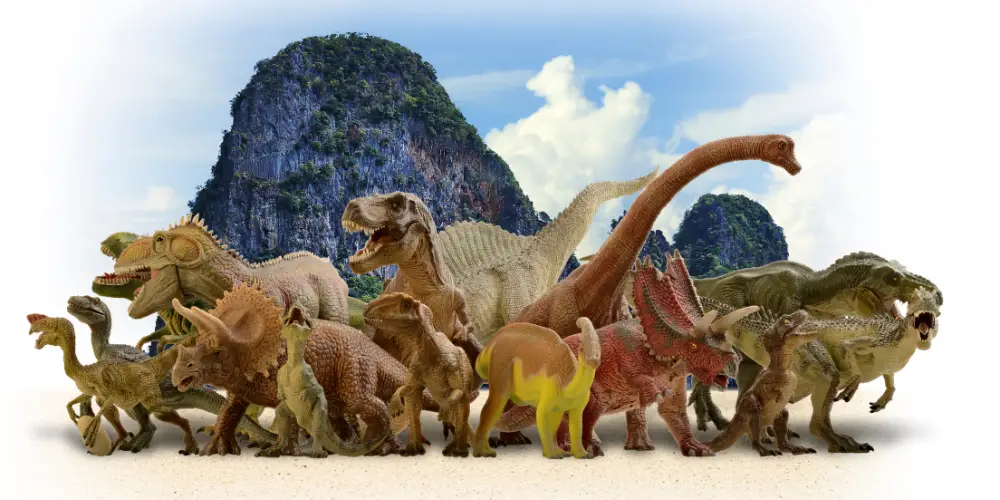Unleashing a primeval spectacle that’s been locked away for 68 million years, let’s step back into the age of the Titans, where the Tyrannosaurus Rex – the thunder lizard king – held supreme dominion.
Experiencing the T-Rex in our mind’s eye is enough to shudder, but have you ever wondered how tall this apex predator stood?
We’re about to journey through time, fossils, and scientific research to unearth the astonishing answer: How tall is the T-Rex?”
The T-Rex’s height, as determined from the most comprehensive fossil specimens, ranged from 3.66 to 3.96 meters, or approximately 12 to 13 feet, at the hips. This measurement emphasizes the considerable size of this prehistoric carnivorous dinosaur.
The Tyrannosaurus Rex: A Brief Overview
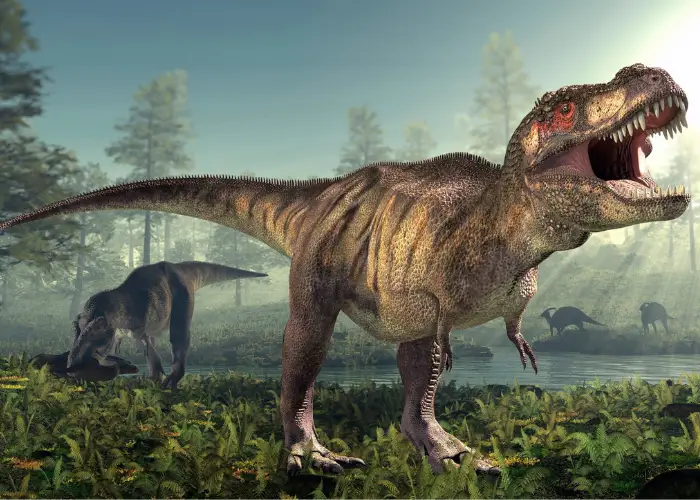
The Tyrannosaurus Rex, whose name translates to “Tyrant Lizard King,” is a species of dinosaur that lived during the late Cretaceous Period, approximately 68 to 66 million years ago.
This colossal creature is one of the most well-known dinosaurs, thanks to its frequent appearances in popular culture, from movies like “Jurassic Park” to children’s books and toys.
The T-Rex was a theropod, a group of bipedal dinosaurs, and is believed to have been one of the largest land carnivores of all time.
A long, heavy tail balanced its massive skull and walked on two robust hind legs. The T-Rex’s forelimbs were notably small relative to its overall size, each with two clawed fingers.
The T-Rex was a formidable predator. Its jaw could have a bone-crushing bite, and its teeth were thick and serrated, perfect for tearing into its prey.
Despite its fearsome reputation, the T-Rex also plays a significant role in understanding dinosaur biology.
Studies of T-Rex fossils have provided insights into everything from growth rates to diseases in dinosaurs. With its towering height and fascinating biology, the T-Rex truly deserves its title as the ‘king’ of the dinosaurs.
Estimating Dinosaur Sizes: The Science Behind the Numbers
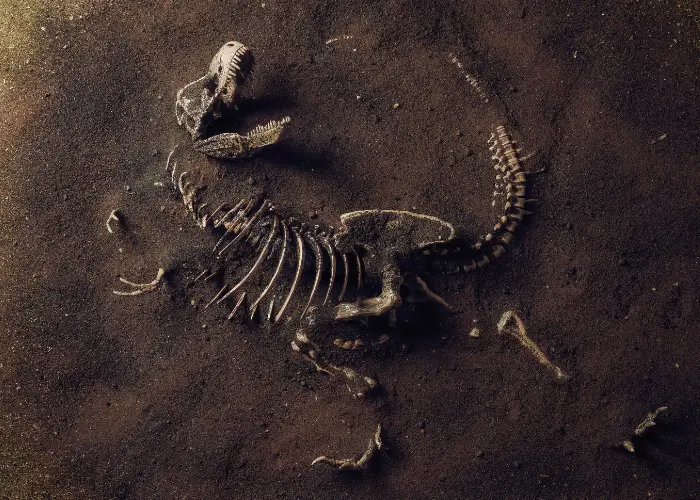
Estimating the size of dinosaurs is a complex process involving paleontology, anatomy, and even detective work.
Scientists primarily rely on fossil evidence to determine the size of these prehistoric creatures.
They use the dimensions of bones, particularly the length of the femur (thigh bone) and the circumference of the humerus (upper arm bone), to estimate the weight and height of the dinosaur.
Comparatively, the T-Rex was one of the largest carnivorous dinosaurs. Its size was rivaled by a few, such as the Spinosaurus and the Giganotosaurus.
However, when compared to herbivorous dinosaurs, the T-Rex falls short. Sauropods like the Argentinosaurus and the Patagotitan significantly outsize the T-Rex, reaching lengths of up to 100 feet and weights of up to 100 tons.
Several factors can influence the size of a dinosaur. These include its diet, environment, and evolutionary adaptations. For instance, larger sizes in carnivorous dinosaurs like the T-Rex may have adapted to hunting larger prey.
Similarly, the massive size of many herbivorous dinosaurs may have been a defense mechanism against predators.
It’s important to note that while these estimates provide a general idea of the size of these reptiles, they are not definitive.
The discovery of new fossils or the application of new techniques can lead to revisions in these estimates as our understanding of these magnificent creatures continues to evolve.
The Height of the T-Rex: Unraveling the Facts

The height of the T-Rex has been a subject of much scientific interest.
Based on the complete specimens found to date, scientists estimate that the T-Rex stood about 12 to 13 feet tall at the hips. ( More about this in the “Fossil Evidence” Section )
This measurement is taken from the ground to the highest point of the hip. Like all theropods, T-Rex stood horizontally with the tail extended behind the body rather than vertically.
From floor to the top of its head, T. Rex could measure over 17 feet (5.1 meters) tall when standing upright.
The Tyrannosaurus Rex had an upright standing height of 15.75-17.7 feet (4.8-5.4 meters)
Estimating the height of the T-Rex involves careful examination and measurement of fossilized bones. The femur and tibia (lower leg bone) are particularly important in these calculations.
By comparing these bones’ lengths with modern animals, scientists can make educated guesses about the T-Rex’s height.
However, it’s important to note that these estimates can vary based on the individual dinosaur’s age and health.
Indeed, there is evidence to suggest that there was considerable variation in size among different T-Rex specimens.
This is unsurprising, as size variation is common in many animal species today. Gender, age, nutrition, and genetic factors could have contributed to size differences among T-Rex individuals.
While we estimate the T-Rex’s height well, much remains to learn. As paleontologists continue to unearth new T-Rex fossils and apply innovative research techniques, our understanding of this iconic dinosaur’s true stature continues to evolve.
The T-Rex in Context: Comparing Sizes

To truly grasp the enormity of the T-Rex, it can be helpful to compare its estimated height to that of modern animals and everyday objects.
For instance, a T-Rex standing 13 feet tall at the hips would be taller than a single-story house and tower over an African elephant, the largest land animal alive today.
Imagine standing next to a school bus. A T-Rex would be approximately the same length, from its snout to the tip of its tail.
In terms of height, if you’ve ever stood next to a giraffe, the tallest living animal, you’d be looking at a creature that reaches a similar height to a T-Rex’s hips.
Visual representations and infographics can be particularly useful in illustrating these comparisons.
For example, a side-by-side comparison of a T-Rex and a human, or a T-Rex and a modern animal, can provide a clear and immediate understanding of the T-Rex’s impressive size.
The T-Rex’s size would have conferred several advantages. Its height would have allowed it to spot prey and threats over long distances.
Despite its massive size, its long, muscular legs could carry it quickly over the terrain. And, of course, its size would have made it a formidable predator, capable of taking down even the largest of its contemporaries.
The T-Rex’s size was key to its success as a species, contributing to its dominance in the late Cretaceous Period.
Debunking Myths: The Truth About the T-Rex’s Size
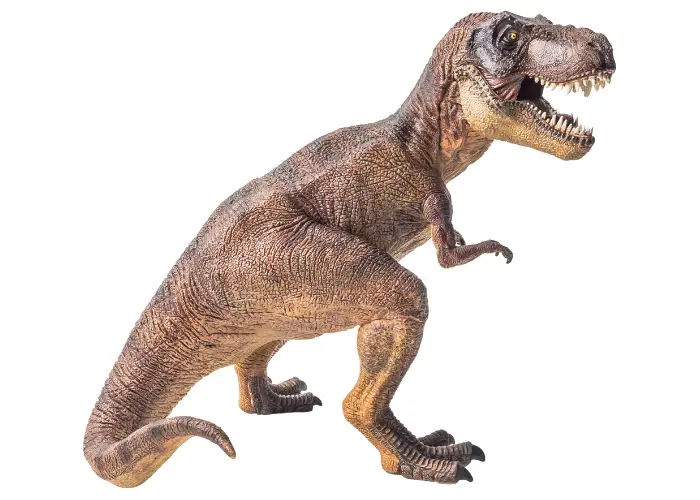
Despite its popularity, many misconceptions exist about the T-Rex, particularly its size.
Let’s address some of these myths and clarify the facts based on scientific evidence.
Myth 1: The T-Rex was the largest dinosaur ever. While the T-Rex was indeed one of the largest carnivorous dinosaurs, it was not the largest dinosaur overall. That title goes to the titanosaur Argentinosaurus and possibly others, herbivores significantly larger than the T-Rex.
Myth 2: All T-Rexes were the same size. Like in modern animal species, T-Rexes would have had size variations. Age, sex, diet, and overall health would have contributed to these differences.
Myth 3: The T-Rex stood upright with its tail on the ground. This is a common misconception often perpetuated by old movies and illustrations. In reality, the T-Rex, like all theropods, had a more horizontal posture with its tail extended behind its body for balance.
Myth 4: The T-Rex’s small arms were useless. While small compared to its overall size, the T-Rex’s arms were extremely strong and likely used for specific purposes, possibly holding prey.
By debunking these myths, we can better understand the T-Rex’s size and how it lived. As always, it’s important to rely on scientific evidence and to remember that our understanding of dinosaurs continues to evolve as discoveries are made.
The Impact of Size: How the T-Rex’s Height Influenced its Lifestyle
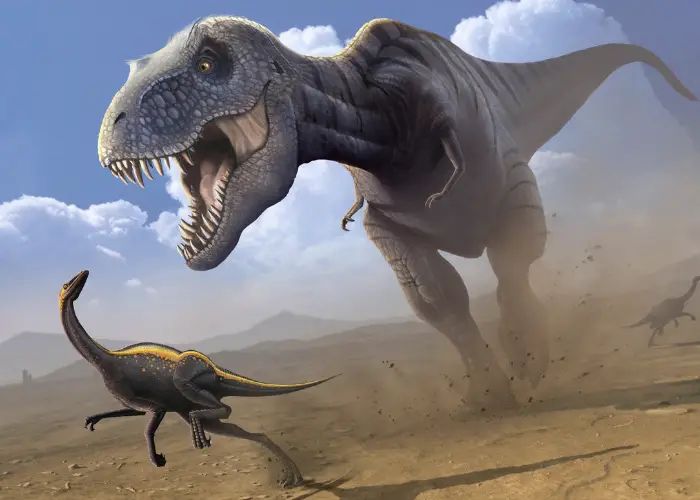
The T-Rex’s impressive size significantly impacted its lifestyle, particularly its hunting and feeding habits, movement, and behavior.
Hunting and Feeding Habits
The T-Rex’s height would have given it a considerable advantage when hunting. Its elevated viewpoint would have allowed it to spot potential prey from a distance.
Additionally, its large size meant it could take down and consume larger prey, providing the substantial food needed to sustain its massive body.
Movement and Behavior
The T-Rex’s size also influenced its movement. Despite its bulk, the T-Rex was likely quite agile, with its long, powerful legs allowing it to move quickly when necessary.
However, its size may have made certain terrains challenging to navigate, influencing where it lived and hunted.
Dominance as a Predator
The T-Rex’s size was crucial to its dominance as a predator.
Few dinosaurs could match the T-Rex in size and strength, making it one of the apex predators of its time. Its size would have also served as an effective deterrent against other predators.
The T-Rex’s size was an impressive statistic and a key factor that shaped its way of life.
From its hunting strategies to its movement and behavior, the T-Rex’s towering stature was pivotal in its survival and dominance during the late Cretaceous Period.
Fossil Evidence: What the Remains Tell Us

Fossil evidence is our primary source of information about the T-Rex, including its size.
Over the years, numerous T-Rex fossils have been discovered, each contributing to our understanding of this iconic dinosaur.
One of the most significant T-Rex discoveries is the “Sue” specimen, currently housed at the Field Museum in Chicago. Sue is the most complete T-Rex fossil ever found, with over 90% of the skeleton recovered.
The measurements of Sue’s bones have provided invaluable data for estimating the size of the T-Rex.
Another notable T-Rex fossil is “Scotty,” discovered in Canada. Scotty is one of the largest T-Rex specimens ever found, and its size has led to discussions about the upper limits of T-Rex size.
These and other T-Rex fossils have given us a wealth of information about the T-Rex’s size. However, there is still much we don’t know.
For instance, we have yet to find a complete growth series of T-Rex fossils, which would show us how the T-Rex grew from a hatchling to an adult.
Additionally, we have few T-Rex fossils from young individuals, limiting our understanding of juvenile T-Rex size and growth.
Ongoing research continues to unearth new T-Rex fossils and apply innovative techniques to existing specimens.
With each discovery and analysis, we get one step closer to fully understanding the size and stature of the T-Rex.
Conclusion
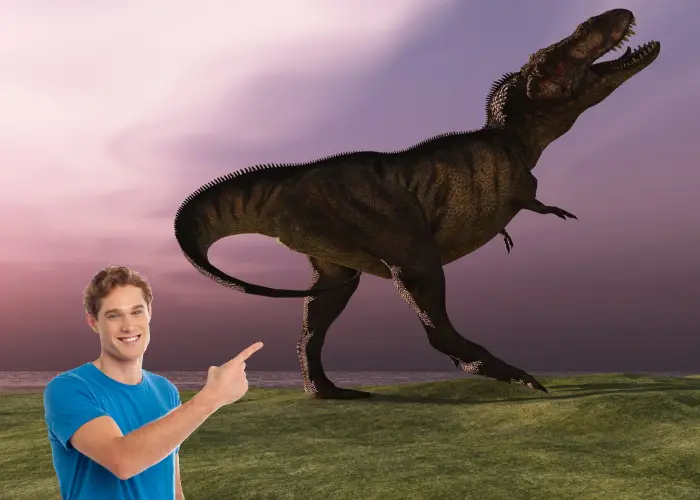
In this article, we’ve delved into the fascinating topic of the T-Rex’s height, exploring scientific estimates, fossil evidence, and the impact of the T-Rex’s size on its lifestyle.
We’ve learned that the T-Rex was one of the largest carnivorous dinosaurs, standing an estimated 12 to 13 feet tall at the hips.
We’ve also discovered that the T-Rex’s size played a crucial role in its hunting habits, movement, and dominance as a predator.
However, it’s important to remember that our understanding of the T-Rex and other dinosaurs continually evolves.
Paleontological research is dynamic, with discoveries and techniques constantly challenging and refining our knowledge.
The T-Rex’s size is just one piece of the puzzle, and there is still much to learn about this iconic dinosaur.
We encourage you to continue exploring the fascinating world of dinosaurs and paleontology.
Whether visiting a museum, reading a book, or even participating in a fossil dig, there are countless ways to engage with this exciting field.
Remember, every fossil holds a story waiting to be unearthed.
CHECK OUT INTERESTING DINOSAUR ARTICLES BELOW:
- The Cutest Dinosaurs Of All Time!
- Are Dinosaurs Real?
- Were Dinosaurs Bulletproof?
- 500 Teeth Dinosaur: Secrets of Toothed Titans
REFERENCES:
- American Museum of Natural History. (2022, January 1). Tyrannosaurus rex. https://www.amnh.org/dinosaurs/tyrannosaurus-rex
- American Museum of Natural History. Dinosaurs. https://www.amnh.org/dinosaurs
- Bates, K. T., Manning, P. L., Hodgetts, D., & Sellers, W. I. (2011). A computational analysis of limb and body dimensions in Tyrannosaurus rex with implications for locomotion, ontogeny, and growth. PLoS ONE, 6(10), e26037. https://doi.org/10.1371/journal.pone.0026037
- American Museum of Natural History. (2015, December 21). Tyrannosaurus rex fossil. https://www.amnh.org/exhibitions/permanent/saurischian-dinosaurs/tyrannosaurus-rex
- Wikipedia contributors. (2001, August 10). Tyrannosaurus. In Wikipedia. https://en.wikipedia.org/wiki/Tyrannosaurus


